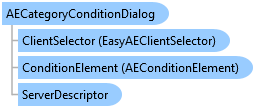

QuickOPC User's Guide and Reference
AECategoryConditionDialog Class


'Declaration<CLSCompliantAttribute(True)> <ComDefaultInterfaceAttribute(OpcLabs.EasyOpc.AlarmsAndEvents.Forms.Browsing.ComTypes._AECategoryConditionDialog)> <ComVisibleAttribute(True)> <GuidAttribute("AF092523-2775-4EC6-A912-4B047711E11D")> <TypeConverterAttribute(System.ComponentModel.ExpandableObjectConverter)> <DesignerCategoryAttribute("Component")> Public NotInheritable Class AECategoryConditionDialog Inherits AEDialog Implements OpcLabs.BaseLib.Forms.ComTypes._FormCommonDialog, OpcLabs.BaseLib.Forms.ComTypes._SizableCommonDialog, OpcLabs.BaseLib.Licensing.ILicensingContextHolder, OpcLabs.EasyOpc.AlarmsAndEvents.Forms.Browsing.ComTypes._AECategoryConditionDialog, OpcLabs.EasyOpc.AlarmsAndEvents.Forms.Browsing.ComTypes._AEDialog, System.ComponentModel.IComponent, System.IDisposable
'UsageDim instance As AECategoryConditionDialog
[CLSCompliant(true)] [ComDefaultInterface(OpcLabs.EasyOpc.AlarmsAndEvents.Forms.Browsing.ComTypes._AECategoryConditionDialog)] [ComVisible(true)] [Guid("AF092523-2775-4EC6-A912-4B047711E11D")] [TypeConverter(System.ComponentModel.ExpandableObjectConverter)] [DesignerCategory("Component")] public sealed class AECategoryConditionDialog : AEDialog, OpcLabs.BaseLib.Forms.ComTypes._FormCommonDialog, OpcLabs.BaseLib.Forms.ComTypes._SizableCommonDialog, OpcLabs.BaseLib.Licensing.ILicensingContextHolder, OpcLabs.EasyOpc.AlarmsAndEvents.Forms.Browsing.ComTypes._AECategoryConditionDialog, OpcLabs.EasyOpc.AlarmsAndEvents.Forms.Browsing.ComTypes._AEDialog, System.ComponentModel.IComponent, System.IDisposable
[CLSCompliant(true)] [ComDefaultInterface(OpcLabs.EasyOpc.AlarmsAndEvents.Forms.Browsing.ComTypes._AECategoryConditionDialog)] [ComVisible(true)] [Guid("AF092523-2775-4EC6-A912-4B047711E11D")] [TypeConverter(System.ComponentModel.ExpandableObjectConverter)] [DesignerCategory("Component")] public ref class AECategoryConditionDialog sealed : public AEDialog, OpcLabs.BaseLib.Forms.ComTypes._FormCommonDialog, OpcLabs.BaseLib.Forms.ComTypes._SizableCommonDialog, OpcLabs.BaseLib.Licensing.ILicensingContextHolder, OpcLabs.EasyOpc.AlarmsAndEvents.Forms.Browsing.ComTypes._AECategoryConditionDialog, OpcLabs.EasyOpc.AlarmsAndEvents.Forms.Browsing.ComTypes._AEDialog, System.ComponentModel.IComponent, System.IDisposable
This is a modal dialog box; therefore, when shown, it blocks the rest of the application until the user has made a selection. When a dialog box is displayed modally, no input (keyboard or mouse click) can occur except to objects on the dialog box. The program must hide or close the dialog box (usually in response to some user action) before input to the calling program can occur.
Icon: ![]()
With AECategoryConditionDialog, your application can integrate a dialog box from which the user can select OPC-A&E condition available on a specified event category:

Use the ServerDescriptor property to specify the OPC Alarms&Events server, and the CategoryId property to specify the event category to be browsed. Then, call the ShowDialog method. If the result is equal to DialogResult.OK, the user has selected the event condition, and information about it can be retrieved from the ConditionElement or ConditionName property.
If you want to change the parameters of the client object the component uses to perform its OPC operations, you can use the ClientSelector Property.
// This example shows how to let the user browse for an OPC Alarms&Events condition available on a specified event category. using System.Windows.Forms; using OpcLabs.EasyOpc.AlarmsAndEvents.Forms.Browsing; namespace FormsDocExamples._AECategoryConditionDialog { static class ShowDialog { public static void Main1(IWin32Window owner) { var categoryConditionDialog = new AECategoryConditionDialog() { ServerDescriptor = {ServerClass = "OPCLabs.KitEventServer.2"}, CategoryId = 0x00EC0002 // Deviation }; DialogResult dialogResult = categoryConditionDialog.ShowDialog(owner); if (dialogResult != DialogResult.OK) return; // Display results MessageBox.Show(owner, $"ConditionElement: {categoryConditionDialog.ConditionElement}"); } } }
# This example shows how to let the user browse for an OPC Alarms&Events condition available on a specified event # category. # The QuickOPC package is needed. Install it using "pip install opclabs_quickopc". import opclabs_quickopc # Import .NET namespaces. from System.Windows.Forms import * from OpcLabs.EasyOpc.AlarmsAndEvents.Forms.Browsing import * categoryConditionDialog = AECategoryConditionDialog() categoryConditionDialog.ServerDescriptor.ServerClass = "OPCLabs.KitEventServer.2" categoryConditionDialog.CategoryId = 0x00EC0002 # Deviation dialogResult = categoryConditionDialog.ShowDialog() print(dialogResult) if dialogResult != DialogResult.OK: exit() # Display results. print('ConditionElement: ', categoryConditionDialog.ConditionElement, sep='')
System.Object
System.MarshalByRefObject
System.ComponentModel.Component
System.Windows.Forms.CommonDialog
OpcLabs.BaseLib.Forms.ConcreteCommonDialog
OpcLabs.BaseLib.Forms.FormCommonDialog
OpcLabs.BaseLib.Forms.SizableCommonDialog
OpcLabs.EasyOpc.AlarmsAndEvents.Forms.Browsing.AEDialog
OpcLabs.EasyOpc.AlarmsAndEvents.Forms.Browsing.AECategoryConditionDialog